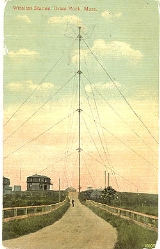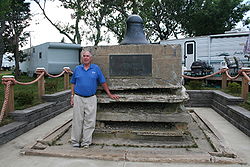
Ocean Bluff-Brant Rock, Massachusetts
Encyclopedia


Census-designated place
A census-designated place is a concentration of population identified by the United States Census Bureau for statistical purposes. CDPs are delineated for each decennial census as the statistical counterparts of incorporated places such as cities, towns and villages...
(CDP) in Plymouth County
Plymouth County, Massachusetts
Plymouth County is a county located in the U.S. state of Massachusetts. As of 2010, the population was 494,919. Its county seats are Plymouth and Brockton...
, Massachusetts
Massachusetts
The Commonwealth of Massachusetts is a state in the New England region of the northeastern United States of America. It is bordered by Rhode Island and Connecticut to the south, New York to the west, and Vermont and New Hampshire to the north; at its east lies the Atlantic Ocean. As of the 2010...
, United States
United States
The United States of America is a federal constitutional republic comprising fifty states and a federal district...
, composed of the villages of Ocean Bluff and Brant Rock in the town
New England town
The New England town is the basic unit of local government in each of the six New England states. Without a direct counterpart in most other U.S. states, New England towns are conceptually similar to civil townships in other states, but are incorporated, possessing powers like cities in other...
of Marshfield. The population was 5,100 at the 2000 census.
History
Brant Rock and Ocean Bluff were originally inhabited by Native Americans, including members of the Wampanoag Tribe of the Algonquian peoplesAlgonquian peoples
The Algonquian are one of the most populous and widespread North American native language groups, with tribes originally numbering in the hundreds. Today hundreds of thousands of individuals identify with various Algonquian peoples...
. Native American artifacts have been found extensively in the area. The main road through the area, known today as "Ocean Street," is a Native American road, likely very ancient. The area at the end of Brant Rock village, known as Blackman's Point, was a Native American campground.
In the 1630s, the government of the Pilgrim settlers at Plimoth Plantation began to give out land grants in the area.
The Ocean Bluff area was first granted to the governor of the Pilgrims. It was known by about 1638 as "Governor's Island." Later on in the 17th century, it became known as "Winter's Island." Christopher Winter was later tried in Plymouth Court for the crime of fathering his own grandchild. Eventually, his daughter married a man named John Hewitt, and he became the owner of Winter's Island. For many generations, including today, the area was known as Hewitt's Island, or Hewitt's Point. However, today most residents refer to the area as "Ocean Bluff."
Brant Rock was originally known as "Branch's Island." The name "Brant Rock" eventually came into use, because of the huge rock outcropping along the beach on which Brant geese would tend to rest. From the 17th century through the late 19th century, the area was primarily used for salt marsh haying, cattle grazing, and for fishing and fowling. In the late 19th century, the area became populated by large summer resort hotels and tourist shops.
Hewitt's Island and Branch's Island were sometimes referred to as the "Spectacle Islands" because together the islands looked like a pair of spectacles or eyeglasses. After the Green Harbor Dyke was built following the Civil War, the tidal salt marshes in the area dried up. The Spectacle Islands were no longer surrounded by water from the tidal flooding of the marshes, and ceased to constitute "islands."
In January, 1906, Reginald Fessenden
Reginald Fessenden
Reginald Aubrey Fessenden , a naturalized American citizen born in Canada, was an inventor who performed pioneering experiments in radio, including early—and possibly the first—radio transmissions of voice and music...
achieved the first two-way transatlantic radiotelegraph transmission, exchanging Morse code
Morse code
Morse code is a method of transmitting textual information as a series of on-off tones, lights, or clicks that can be directly understood by a skilled listener or observer without special equipment...
messages between his stations in Brant Rock and Machrihanish
Campbeltown
Campbeltown is a town and former royal burgh in Argyll and Bute, Scotland. It lies by Campbeltown Loch on the Kintyre peninsula. Originally known as Kinlochkilkerran , it was renamed in the 17th century as Campbell's Town after Archibald Campbell was granted the site in 1667...
, Scotland
Scotland
Scotland is a country that is part of the United Kingdom. Occupying the northern third of the island of Great Britain, it shares a border with England to the south and is bounded by the North Sea to the east, the Atlantic Ocean to the north and west, and the North Channel and Irish Sea to the...
. (Marconi
Guglielmo Marconi
Guglielmo Marconi was an Italian inventor, known as the father of long distance radio transmission and for his development of Marconi's law and a radio telegraph system. Marconi is often credited as the inventor of radio, and indeed he shared the 1909 Nobel Prize in Physics with Karl Ferdinand...
had only achieved one-way transmissions prior to his date). On Christmas Eve
Christmas Eve
Christmas Eve refers to the evening or entire day preceding Christmas Day, a widely celebrated festival commemorating the birth of Jesus of Nazareth that takes place on December 25...
, December 24, 1906, Fessenden transmitted from Brant Rock Station the first audio radio broadcast
Broadcasting
Broadcasting is the distribution of audio and video content to a dispersed audience via any audio visual medium. Receiving parties may include the general public or a relatively large subset of thereof...
of music and entertainment in history. Radio operators on ships in the Atlantic heard a broadcast that included Fessenden playing the song O Holy Night
O Holy Night
"O Holy Night" is a well-known Christmas carol composed by Adolphe Adam in 1847 to the French poem "Minuit, chrétiens" by Placide Cappeau , a wine merchant and poet, who had been asked by a parish priest to write a Christmas poem...
on the violin and reading a passage from the Bible
Bible
The Bible refers to any one of the collections of the primary religious texts of Judaism and Christianity. There is no common version of the Bible, as the individual books , their contents and their order vary among denominations...
.
Geography
Ocean Bluff and Brant Rock are located at 42°6′6"N 70°39′39"W (42.101561, -70.660787).They are 2 quaint seaside 'villages' of Marshfield MA.
According to the United States Census Bureau
United States Census Bureau
The United States Census Bureau is the government agency that is responsible for the United States Census. It also gathers other national demographic and economic data...
, the CDP has a total area of 11.3 km² (4.4 mi²). 5.3 km² (2.0 mi²) of them is land and 6.0 km² (2.3 mi²) of them is water. The total area is 53.09% water.
Ocean Bluff (02065) and Brant Rock (02020) contain 6 public beaches: Sunrise Beach, Ocean Bluff Beach, Rebar Beach, Brant Rock Beach, Blackman's Point, and Bluefish Cove. All of these beaches, as well as the rest of the Marshfield seashore from Green Harbor village to Rexhame village, were once known by the name of "Marshfield Beach." In 1832, the Supreme Judicial Court of Massachusetts ruled in the case of Briggs Thomas v. Inhabitants of Marshfield, 13 Pickering 240, that Rexhame beach as well as the all of rest of "Marshfield Beach" was a "common", open for use by all members of the public.
Demographics
As of the censusCensus
A census is the procedure of systematically acquiring and recording information about the members of a given population. It is a regularly occurring and official count of a particular population. The term is used mostly in connection with national population and housing censuses; other common...
of 2000, there were 5,100 people, 2,004 households, and 1,320 families residing in the CDP. The population density
Population density
Population density is a measurement of population per unit area or unit volume. It is frequently applied to living organisms, and particularly to humans...
was 960.5/km² (2,489.5/mi²). There were 2,657 housing units at an average density of 500.4/km² (1,297.0/mi²). The racial makeup of the CDP was 98.35% White, 0.29% African American, 0.08% Native American, 0.29% Asian, 0.29% from other races
Race (United States Census)
Race and ethnicity in the United States Census, as defined by the Federal Office of Management and Budget and the United States Census Bureau, are self-identification data items in which residents choose the race or races with which they most closely identify, and indicate whether or not they are...
, and 0.69% from two or more races. Hispanic or Latino of any race were 0.53% of the population.
There were 2,004 households out of which 32.4% had children under the age of 18 living with them, 49.2% were married couples
Marriage
Marriage is a social union or legal contract between people that creates kinship. It is an institution in which interpersonal relationships, usually intimate and sexual, are acknowledged in a variety of ways, depending on the culture or subculture in which it is found...
living together, 13.3% had a female householder with no husband present, and 34.1% were non-families. 26.5% of all households were made up of individuals and 8.2% had someone living alone who was 65 years of age or older. The average household size was 2.54 and the average family size was 3.14.
In the CDP the population was spread out with 25.5% under the age of 18, 5.9% from 18 to 24, 33.0% from 25 to 44, 25.1% from 45 to 64, and 10.5% who were 65 years of age or older. The median age was 38 years. For every 100 females there were 94.7 males. For every 100 females age 18 and over, there were 90.1 males.
The median income for a household in the CDP was $56,840, and the median income for a family was $60,552. Males had a median income of $42,388 versus $35,902 for females. The per capita income
Per capita income
Per capita income or income per person is a measure of mean income within an economic aggregate, such as a country or city. It is calculated by taking a measure of all sources of income in the aggregate and dividing it by the total population...
for the CDP was $24,292. About 3.1% of families and 5.3% of the population were below the poverty line, including 7.6% of those under age 18 and 3.4% of those age 65 or over.

